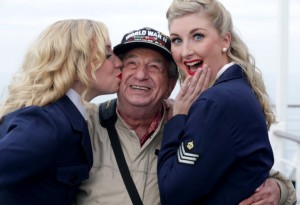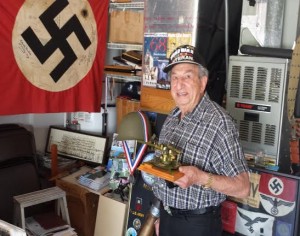
Irving Locker made his first visit to the beaches of Normandy in early June since he was part of the Allied D-Day invasion that pushed back the Nazis and ended World War II.
After battling through the Nazi bunkers along the shore, living in foxholes, pressing inland through frigid weather to the Battle of the Bulge, coming across horrific Nazi death camps and ending the march along the Elbe River near Berlin, Locker said he had no desire to return to those beaches for a sightseeing trip.
“Why would I want to go back?” he asked. “We had nothing. We lived out of our helmets.”
This time, however, was different. The two-week trip with his wife, Bernice, was with a 55-member British group called D-Day Revisited. One American soldier and sailor were chosen to travel with the group and Locker said he was selected thanks to villager Jean Downs. The trip’s purpose on the 70th anniversary of the invasion was to honor those who died.
The group traveled with drums and bagpipes to assist in the memorial ceremonies. Unlike Locker, many of the travelers, now in their 90s, were in wheelchairs or used canes.
“It was an experience I will never forget,” said Locker, who lived most of his life in New Jersey where he ran a graphic arts business.
It started with a stop in England, where Locker was stationed as part of the Tiger Exercise, a series of practice sessions for the invasion with live ammunition. The trip continued to the Normandy beaches, where the group placed wreaths honoring the dead. They went to Sword Beach, where world leaders including President Obama and Russia’s Vladimir Putin, had gathered.
“They had closed the schools,” Locker said. “Everybody was on the streets clapping for us and honoring us in any way they could.”
Now 89 and a villager for six years, Locker was a 19-year-old staff sergeant at the time of the invasion. The 25 miles of dangerous and desolate beaches where the Allied Forces landed now are populated by swimmers, sunbathers and restaurant diners.
He was at Exmouth in England for the Tiger Exercise and 946 American soldiers were killed when German ships arrived to disrupt the proceedings. The deaths were kept secret until after the invasion.
The ocean was so rough on D-Day that Locker said one of the 90-millimeter guns his unit handled went overboard and was lost. The French later retrieved the big gun and put it on display at the Utah Beach Museum. Locker placed a wreath on it during his trip.
He served with the 116th AAA Gun Battalion in the 1st Army’s 7th Corps under the leadership of generals Omar Bradley and Joe Collins. He said the AAA stands for anti-aircraft, anti-tank and artillery.
Fifteen of the 9 ½-ton guns made it to shore. He said the guns could fire up to 30,000 feet into the air to take out enemy planes and also could effectively pierce German tanks.
When the troops stormed the beach through the ocean waves, Locker said the weight of their packs made it more difficult.
“If you tripped in any way, you were dead,” he said.
The march to Berlin was no easier.
“The big thing, of course, were the supplies,” he said.
A massive trucking operation called the Red Ball Express brought everything including food, fuel, water and ammunition to the advancing troops.

Locker said one of his jobs was to disable any German planes that came down, killing or capturing the pilots.
“I was the biggest thief they had, but they called it a procurement officer,” he said.
He took the seat out of a farmer’s outhouse so his men could be more comfortable and took part of the roof from a Nazi barracks so they could sleep under shelter. He brought back war souvenirs such as a Nazi flag signed by members of his unit and a shell from one of the big guns.
His unit also came across Nazi death camps. He said General Eisenhower encouraged everyone to take pictures because he predicted that someday, some people would question whether it ever happened.
“When I got to this, I just threw up and sat down and cried,” said Locker, who is Jewish.
These days, he shows those disturbing photos to children when he makes school presentations.
“Lest we forget,” he said.

